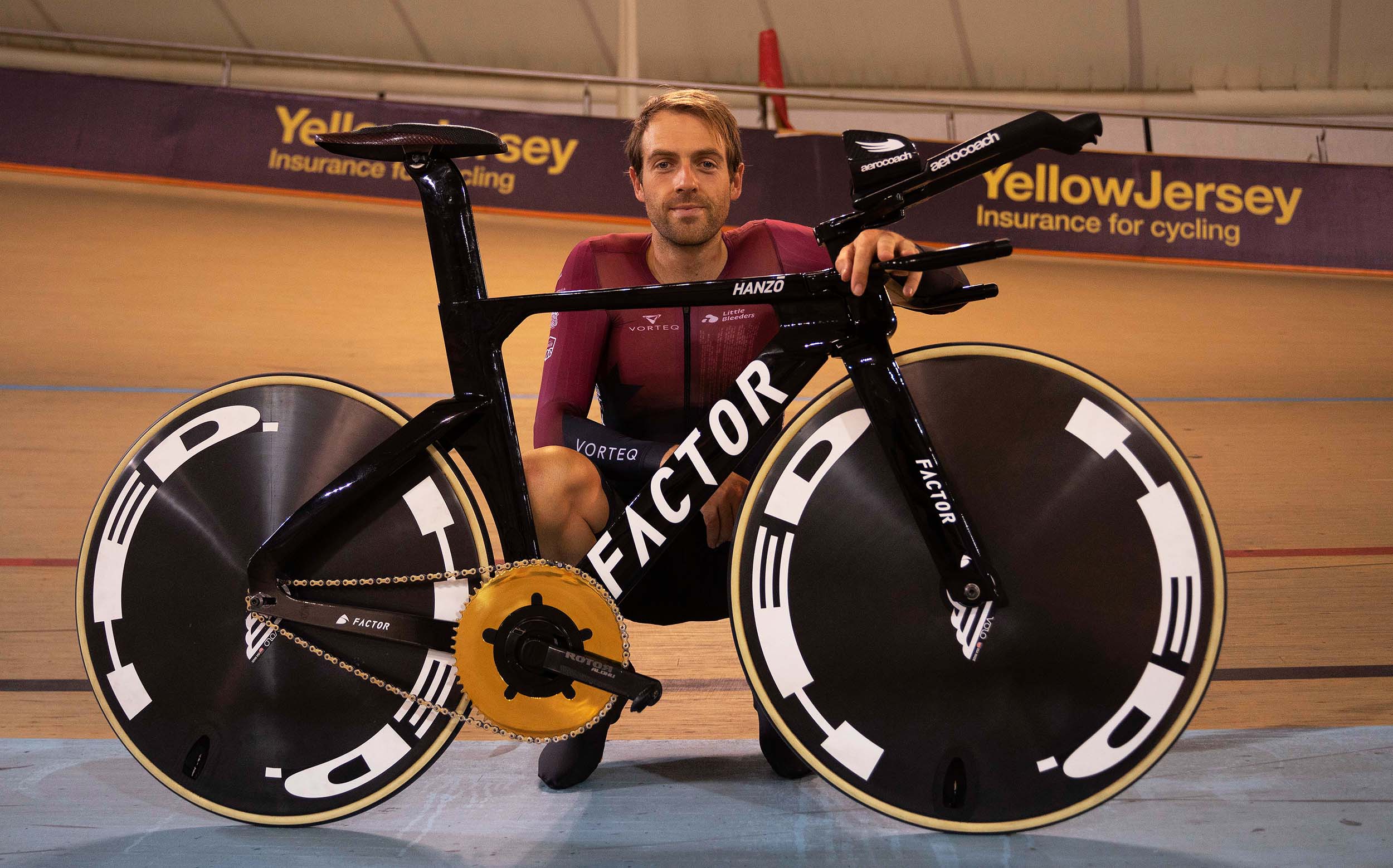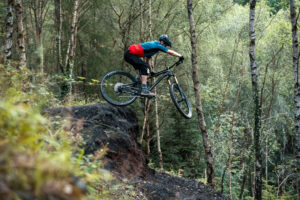Physics of The Hour Record

On November the 3rd 2021 Alex Dowsett will be making another attempt on the hour record. To succeed, Alex and his team will need a lot of planning, and a bit of physics. The hour record is not just a case of turning up and seeing how you go. With each attempt, there’s a team of scientists, aero-engineers and miscellaneous boffins calculating, number crunching, and coding to plan how hard a rider must go.
Alex has said on his YouTube channel that he needs to maintain over 340W for the attempt to be successful. This doesn’t sound like much, but riding at thispower almost 1900m above sea level while folded in half on a TT bike is no easy feat. This piece won’t go into minute detail about the science behind an hour record – quite frankly there’s not time – but it will aim to give you an idea of how a physicist might approach the problem.

Before we start it’s worth thinking about some rules in physics, which you may have learned in school or even seen here. These are Isaac Newton’s laws of motions –today we focus on the first and second of these laws (there’s three).
Newton’s first law of motion states that an object at rest, or moving at a constant velocity, will remain at rest, or a constant velocity, unless acted upon by a force. While pedalling around a velodrome there are obviously many forces at play all changing constantly but this law is a useful approximation to keep in mind. Newton’s second law of motion states that an object will accelerate at a rate proportional to the force applied to this object. This is a useful law to think about in the context of the start – as the hour record requires riders to begin stationary.
One thing a physicist might do is take a complex situation and simplify it. This is to make discovery and discussion of underlying principles simpler. In order to make the process of the hour record as simple as possible we will split the attempt into two phases. The first phase involves Alex getting up to speed. The second phase involves staying at that speed. Newton’s second law deals with acceleration and Newton’s first law deals with staying at speed.
In order to break the record Alex needs to ride at a speed of more than 55.089km per hour for an hour, from a standing start. Accelerating is a balancing act – the faster you’re up to speed then the slower you must ride but accelerating harder is less efficient from a physiological standpoint. This is like the fact that accelerating harder in your car burns more fuel. What we often see is riders discussing a “schedule” when attempting the hour record – they’ll have targets for each lap usually coupled with a coach shouting lap times with them during the effort. Bike computers are not allowed for the hour record.

Here we have a mock-up graph of some different time schedule options, the dotted green line represents the current record, and the two solid lines are different pacing options. This shows there are multiple ways to break the record provided the average of the numbers which create the orange and blue lines is greater than the dotted green line. If we look at the two solid lines, we see the blue line accelerates up to speed quickly and then remains at a lower constant speed whereas the orange line accelerates slowly throughout. In reality, these differences are not as pronounced as seen in this figure, but it shows us there’s many ways to approach the record. Alex has said that he’ll “ride to Victor’s schedule” and try and pick it up at the end.
Once Alex is up to a constant speed we can start thinking about all of the forces acting on him and his bike which are either slowing him down or speeding him up. In reality the picture is more complicated as he’s travelling around a velodrome changing direction almost constantly. For the purpose of our analysis, we will imagine that he’s travelling in a straight line at a constant speed. This allows us to discuss most of the important principles without adding in layers of complexity.
We can write a rough list of the forces and each item in this list can, of course, be separated further – we can always make physics more complicated but the key to thinking about a problem is to keep your system it as simple as possible. The forces are…
His legs, Alex is peddling (quite hard) so putting force through the pedals
The air, friction with the air is slowing Alex down
The floor, friction with the floor is also slowing down Alex
Friction in the bike, heat generated in the moving parts on the bike is also slowing Alex down
We can write this as an equation which we can then use to work some stuff out. We know that the forces moving Alex forward are equal to the forces slowing him down – as his speed is constant.
![]()
This equation may look very complicated to you, or very simple, depending on your background. For our purposes the algebra ends there but we will look at each term in the equation. Firstly, we know that the term on the left-hand side of the equals sign, , is equal to the sum of all the turns on the right. Let’s think about all the terms on the right-hand side one by one…
The first term represents the drag force that Alex spends as much time as possible trying to minimise. He’s spent time in the wind tunnel having custom kit from Vorteq made for him, testing his Factor track bike as well as testing which combination of wheels is fastest. Often you will hear cyclists talking about and this is a number that contributes to how big the drag force is. Alex works hard on lowering this at every wind tunnel session. This is the most important factor in Alex’s case, his drag force will be what slows him down more than anything else. He’s had a custom skin-suit made for this attempt which matches the environment and his body shape to make him as aerodynamic as possible.
We asked Alex about his wind tunnel test, featured in the video above. He said, “The most recent test was confirming the work that’s been done translates into the full package. I’ve done so much testing now that there’s no surprise gains sadly. The Factor we know is fast, and it’s so wide that we don’t have to be concerned by wheel/frame interaction. The HJC has consistently been the fastest helmet on me, we tested the Kask Mistral in a large size after learning that it had been performing well on a lot of riders, but it was no faster. I think we’ve arrived at the hour with the best possible setup, which is encouraging not having to compromise for any material sponsors”.
The second represents the friction forces in the bike which Alex is riding. Friction is generated when two surfaces move against each other, this causes energy to be released in the form of heat. Any energy released as heat is bad news for Alex, it’s energy that could have been used for forward motion. A specialist treated chain and ceramic speed bearings will help Alex to reduce this as much as possible in his hour record attempt.
The third this represents the friction between the tyres and the floor. Alex will have worked hard to test and select the fastest possible tyres on his bike for this record attempt as well as the pressure these tyres are pumped up to. If you want to look at rolling resistance data for your next time trial – check out a great resource here!
Physics is not the only scientific discipline used in the hour record. Broadly speaking the other two are nutrition and psychology. We know Alex has trialled “aggressive nitrate loading” at British Championships showing us that it’s important to do these things before the big day. This had some interesting results and we are sure Alex learned a lot and will nail his race day nutrition. Alex has done an hour record before but going as hard as you possibly can for an hour on a velodrome is obviously a mentally challenging task. It requires immense focus. In a sport with such fine margins, it only takes a few laps of lost focus to drift off schedule or cook yourself.
Alex has a team of scientists around him working on his hour record attempt. Yellow Jersey, while not providing him with any scientists, are proud to be supporting this effort and believe that Alex Dowsett’s hour record attempt will be successful on November 3rd 2021.







